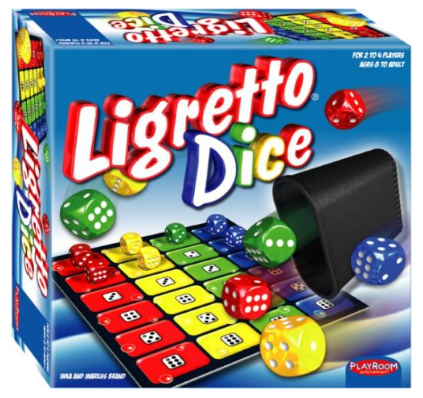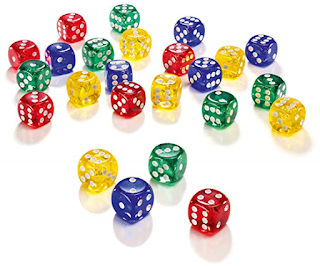 |
Ligretto Dice - Each player gets a handful of dice. |
In the box: Game board, 24 dice (6 each of 4 colors), 4 dice cups
Forget the dice cups and use Ligretto Dice as an opportunity to cup the hand(s) over and over in each game, to work on developing palmar arch strength and support as you play. The colorful board and semi-transparent dice add to the interest of Ligretto Dice. The board shows six dice of each color, numbered from 1 to 6. You can see everything in the image above.
Object:
Be the first player to place all 6 of your dice on the game board.
Set up:
Put the game board in the middle of the playing surface. Give each play six dice, all the same color. This is the color of the strip on the game board that you will be covering.
Play:
Players all play at the same time, throwing their dice and matching them to the dice and their color on the board. No matches? Dice that don't match are thrown over and over, as many times as necessary to get what you need to cover all six of your dice on the board. Be quick, the first person to play all six of his dice wins the game.
Try this:
- Ask the person to curl the fingers together and keep the hand(s) cupped while shaking the dice until the count of 10 or until you say a simple rhyme. Place two cupped hands side of side while shaking or placed one cupped hand on top of the other cupped hand while shaking. Lots of ways to play.
- Ask the individual to pick up one die at a time, roll it in the fingertips without using a support surface (table, body) and place it on the matching square on the board.
- Place one die at a time in the individual's hand (base of fingertips, moving back toward the palm). Ask him to move it to the fingertips, rotate it, and place it on the board.
- Place 2 dice in the individuals palm, ask him to bring one to the fingertips to rotate for placement while holding the other without dropping. Then move it to the fingertips for placement.
- Pick up the dice one at a time and squirrel them in the palm while putting the game away. How many can you hold? Drop them into the box by handfuls.
- Add the dice cups back in. Sort the four colored dice into the four cups and practice using graded movements to pour out only one die at a time to empty the cups.
- Throw the dice. Make a pattern of say 4 dice. Ask the individual to make a pattern just like it and then keep going as long as he can with the pattern. Pick up the dice one at a time and turn them in-hand to get the side you want.
- Stack four towers of same-color dice. Stack them from one to six, or from six to one, or just randomly.
- Play alone and throw all the dice. Quickly place them on the board. Turn them in-hand as necessary to get the number you need. Time yourself and see how long it takes. Play again and try to beat your time.
- Make one tall tower of dice. How many can you stack before they fall?
- Cup the hands side-by-side and shake all the dice. Throw them on the table. Pick up all the number 1 dice. Squirrel them in the hand as you pick them up. Drop them into the box. Repeat and pick up all the number two dice. Play until all the dice are back in the box.
- Work on palmar arch strength and support, precision fine motor, in-hand manipulation, manual dexterity, visual discrimination, figure ground, spatial relations, sequencing, socialization skills, process skills, executive functioning skills, play and leisure exploration and participation, processing speed




No comments:
Post a Comment
Thank you for taking the time to comment.